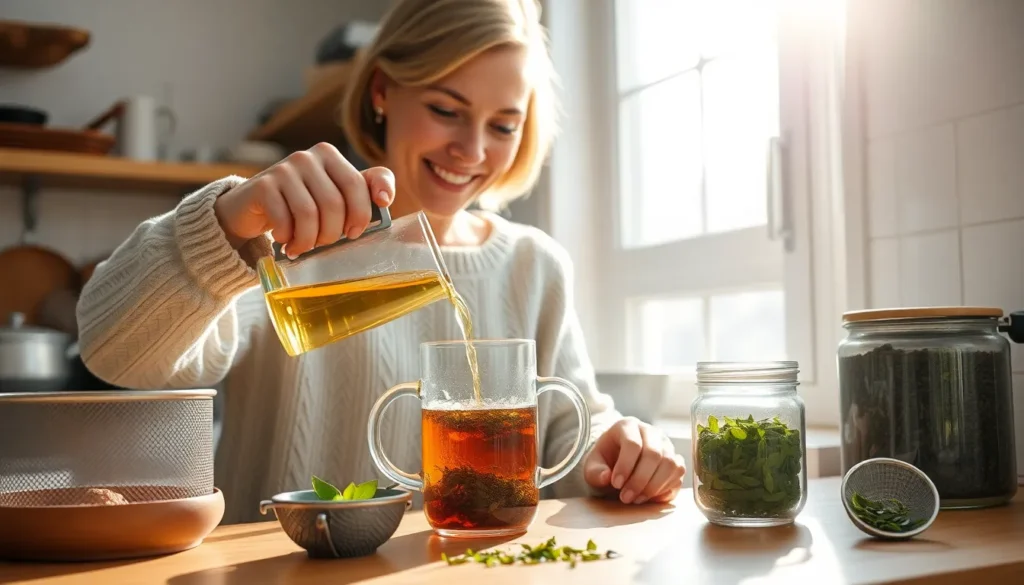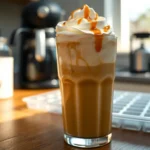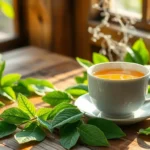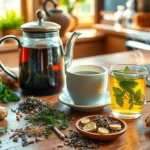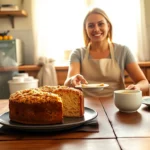We’ve all been there – craving a perfect cup of loose leaf tea but lacking the proper infuser or strainer. Don’t let missing equipment stop you from enjoying premium tea leaves! While tea infusers make the process convenient there are several clever methods to brew loose leaf tea using everyday kitchen items.
The secret lies in understanding that tea brewing is simply about steeping leaves in hot water and then separating them before drinking. Whether you’re dealing with delicate white tea or robust black tea varieties these techniques will help you extract maximum flavor without any specialized tools.
From the traditional grandpa style method to creative kitchen hacks using coffee filters and fine-mesh sieves we’ll show you how to transform loose leaves into the perfect cup. These methods aren’t just emergency answers – many tea enthusiasts actually prefer them for the fuller flavor extraction they provide.
What You’ll Need
The beauty of brewing loose leaf tea without an infuser lies in its simplicity. We’ll show you exactly what household items can transform into effective tea-brewing tools.
Essential Equipment
Loose leaf tea forms the foundation of our brewing adventure. Quality loose leaf tea delivers superior flavor compared to bagged alternatives and provides the perfect canvas for our infuser-free methods.
Hot water serves as our brewing medium. Fresh filtered water heated to the appropriate temperature for your tea type ensures optimal extraction without bitterness.
A teapot or large mug acts as our brewing vessel. Any heat-resistant container with enough room for tea leaves to expand works perfectly for our purposes.
Fine-mesh kitchen strainer becomes our primary separation tool. Most kitchens already contain this versatile item that effectively catches tea leaves while allowing liquid to flow through.
Coffee filters offer an excellent backup option. These readily available items create makeshift tea bags when folded or can line strainers for extra filtration power.
Optional Tools
Small bowl or cup provides convenience when using the grandpa style method. This additional vessel allows us to temporarily hold strained tea while we remove spent leaves from our main brewing container.
Cheesecloth or clean kitchen towel creates DIY tea sachets. These fabric options work beautifully for delicate teas that might slip through standard strainers.
Slotted spoon helps with leaf management during brewing. We can use this tool to gently stir leaves or remove them partially through the steeping process.
Timer ensures precise brewing times. While not essential this simple tool prevents over-steeping and guarantees consistent results every time we brew.
Ingredients
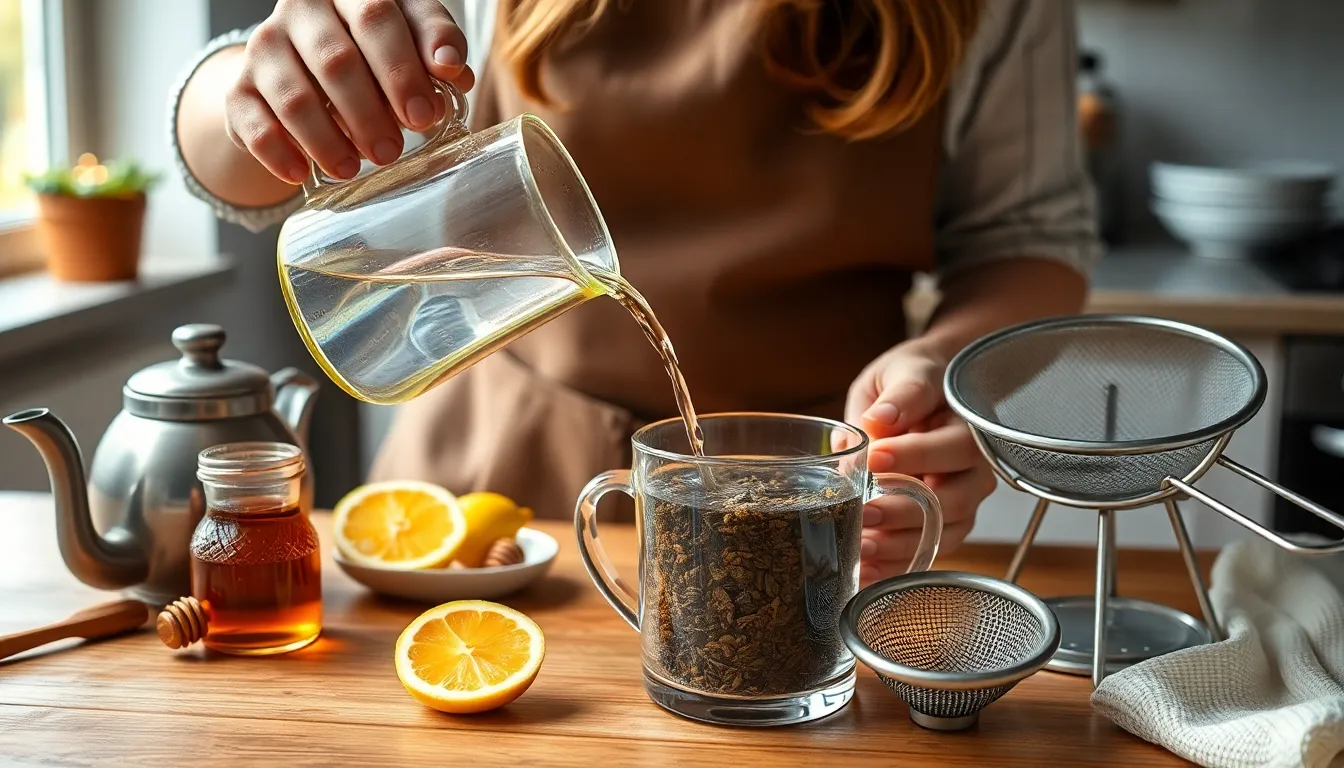
For brewing loose leaf tea without an infuser, we need just a few basic ingredients that most kitchens already have on hand. The beauty of these methods lies in their simplicity and accessibility.
Essential Ingredients:
- 2-3 teaspoons loose leaf tea (adjust quantity based on desired strength and tea type)
- 8-10 ounces filtered water (heated to appropriate temperature for your tea variety)
Optional Enhancement Ingredients:
- Honey or sugar (to taste, if desired)
- Fresh lemon slices (for citrus teas or black teas)
- Milk or cream (for stronger black teas)
Kitchen Items You’ll Use:
- Fine-mesh kitchen sieve or sifter (for the straining method)
- Mason jar with lid (for the jar technique)
- French press (if using the press method)
- Aluminum foil (for creating a DIY infuser)
- Large mug or teapot (as your brewing vessel)
The loose leaf tea serves as our primary ingredient, providing the flavor foundation for our brew. We recommend measuring approximately one teaspoon per cup of water, though stronger teas like black varieties may require slightly less while delicate white teas often benefit from an extra half teaspoon. Quality filtered water ensures optimal extraction without interfering minerals that might affect taste. Each method we’ll explore uses these same basic ingredients while employing different household items to achieve proper leaf separation.
Method 1: The Strainer Technique
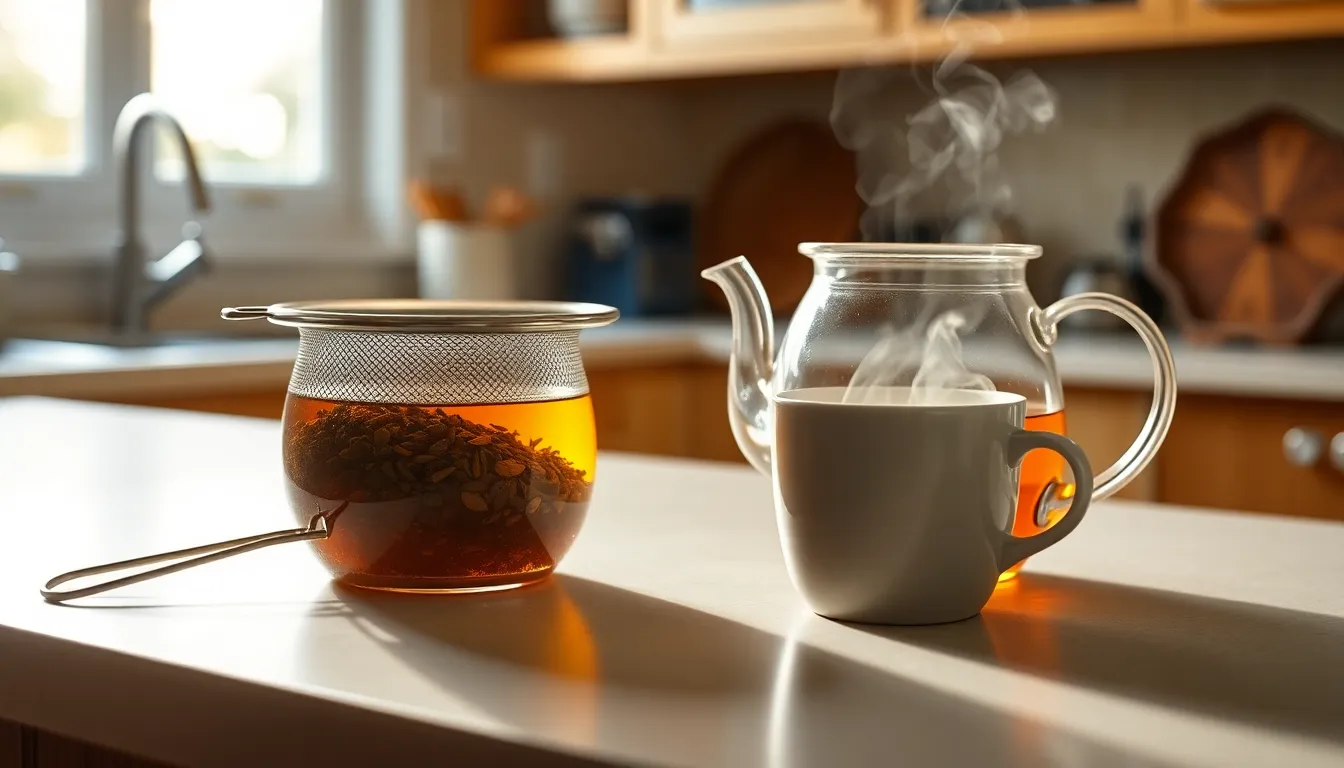
This method transforms any fine-mesh kitchen strainer into an effective tea brewing tool. We’ll guide you through the straightforward process that delivers smooth, flavorful tea using items you likely already have in your kitchen.
Prep
We start by gathering our essential brewing components. Place your loose leaf tea, hot water, a cup or teapot for steeping, and a fine-mesh sieve or kitchen strainer within easy reach. Choose a small sieve when possible, though any fine-mesh strainer will effectively catch loose leaves and prevent them from entering your cup. Avoid using a colander since its holes are too large and will allow tea leaves to pass through into your final brew.
Brew
We place the loose leaf tea directly into our teapot or heatproof container without any barriers. Pour hot water over the leaves, ensuring complete coverage for optimal extraction. Allow the tea to steep for the recommended time based on your exact tea type, typically 3 to 5 minutes, which releases the full flavor profile from the leaves.
Strain
Once brewing is complete, we pour the tea through our fine-mesh sieve into the drinking cup. The sieve catches all loose leaves while allowing the clear, flavorful liquid to flow through smoothly. Position the sieve directly over your cup if it fits properly, or you can steep the tea directly in the cup and strain it afterward using this same technique. This final step ensures we achieve a clean cup of tea without any floating leaves or debris.
Method 2: The French Press Method
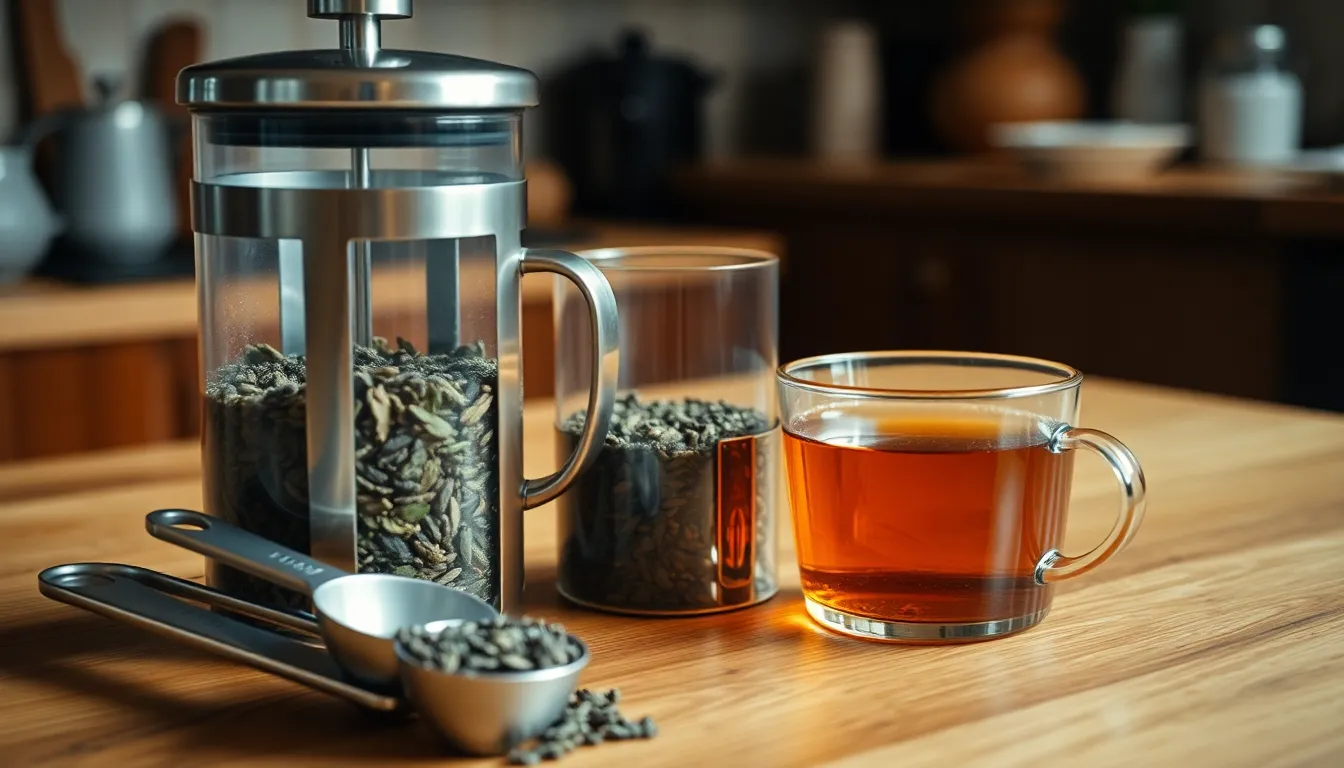
The French press transforms from a coffee maker into an excellent tea brewing vessel when we need to brew loose leaf tea without a traditional infuser. This method provides complete control over steeping time while effectively separating leaves from the finished brew.
Prep
We start by selecting our preferred loose leaf tea and measuring approximately 1 teaspoon per 8 ounces of water we plan to use. Our French press needs a thorough cleaning to remove any coffee residue or grounds that might affect the tea’s flavor.
Essential preparation steps:
- Choose quality loose leaf tea
- Measure 1 teaspoon tea per 8 oz water
- Clean French press completely
- Remove all coffee oils and residue
Brew
We place the measured loose leaf tea directly into the bottom of our clean French press. Fresh water gets heated to the appropriate temperature for our exact tea type. Green and white teas require cooler water at 160-180°F while black and herbal teas need water just off the boiling point.
Temperature guidelines:
| Tea Type | Water Temperature |
|---|---|
| Green Tea | 160-180°F (70-80°C) |
| White Tea | 160-180°F (70-80°C) |
| Black Tea | Just off boiling |
| Herbal Tea | Just off boiling |
We pour the heated water over the tea leaves in the French press and place the lid on top without pressing the plunger down. The steeping time varies by tea type but typically ranges from 2-5 minutes for optimal flavor extraction.
Press and Pour
After the steeping time completes we slowly push the plunger down to separate the brewed tea from the leaves. The pressing motion should be gentle and steady to avoid forcing bitter compounds from the leaves into our tea.
We pour the tea immediately into our cups or transfer it to another vessel to prevent over steeping. Leaving the tea sitting with the pressed leaves continues the extraction process and creates a bitter brew.
- Press plunger slowly and steadily
- Pour tea immediately after pressing
- Transfer to serving vessel if not drinking right away
- Rinse French press thoroughly after use
- Adjust tea-to-water ratio based on taste preferences
Method 3: The Coffee Filter Method
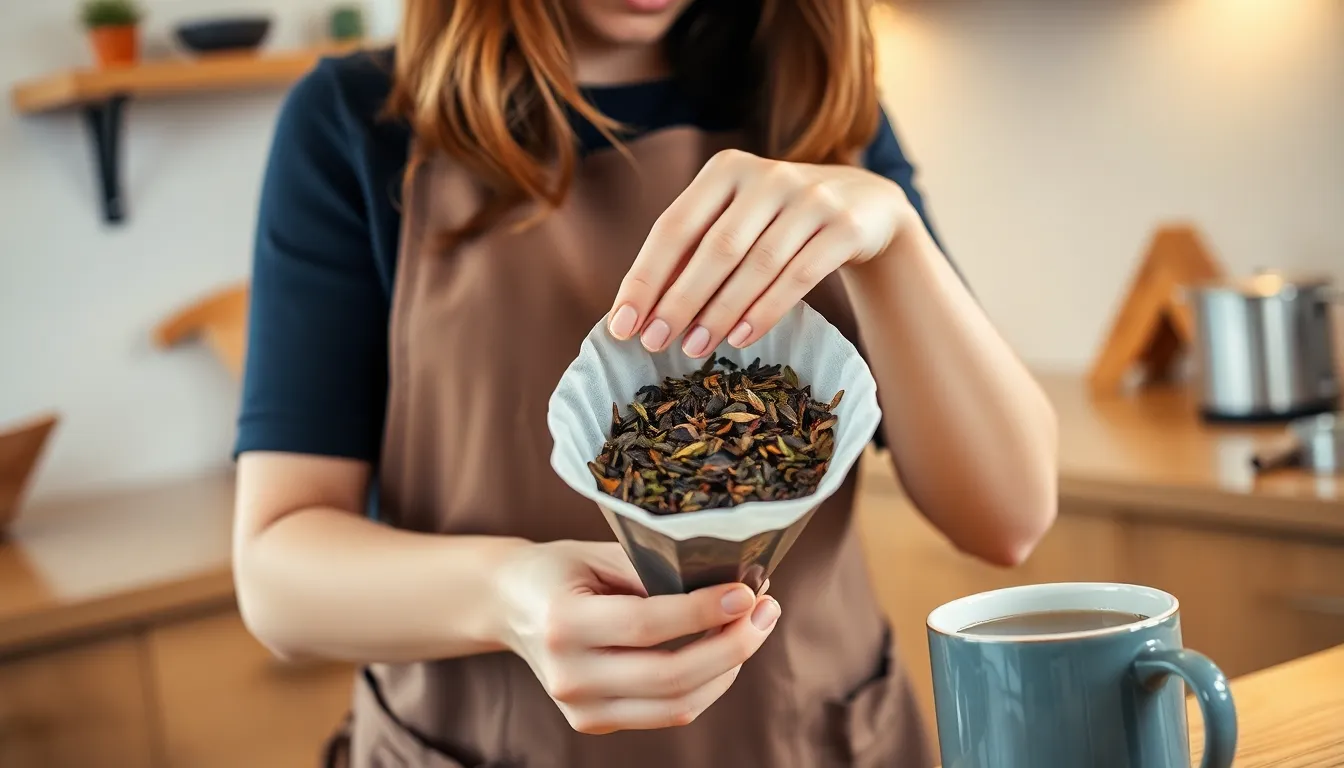
Coffee filters offer an ingenious solution for brewing loose leaf tea when traditional infusers aren’t available. This household staple creates an effective makeshift tea bag that filters leaves while allowing full flavor extraction.
Prep
We gather our loose leaf tea and select a clean coffee filter or paper towel as our filtering medium. A standard mug serves as our brewing vessel while we prepare hot water using our preferred heating method. Our favorite loose leaf tea variety takes center stage as we measure the appropriate amount for steeping. Fresh filtered water heated to the correct temperature for our chosen tea type ensures optimal flavor extraction.
Setup
We open the coffee filter completely and place 2-3 teaspoons of loose leaf tea in the center of the filter. The tea leaves get enclosed by folding the filter over them to create a secure pouch. Staples or twist ties help us seal the edges while we carefully avoid creating sharp points that might tear the filter. Our alternative approach involves holding the filter-wrapped tea directly over the mug during the brewing process for those who prefer manual control.
Brew and Filter
We pour the heated water directly over our coffee filter pouch positioned in the mug. The tea steeps for the recommended time based on our exact tea variety while the filter contains all loose leaves. Our brewing times follow standard guidelines with green teas steeping 2-3 minutes and black teas requiring 3-5 minutes for full flavor development. The coffee filter prevents any tea particles from entering our cup while allowing the rich tea liquor to pass through freely. We remove the used filter pouch once steeping completes and dispose of both the leaves and filter responsibly. The result delivers a clean flavorful cup of tea without any floating debris.
Method 4: The Fine Mesh Sieve Method
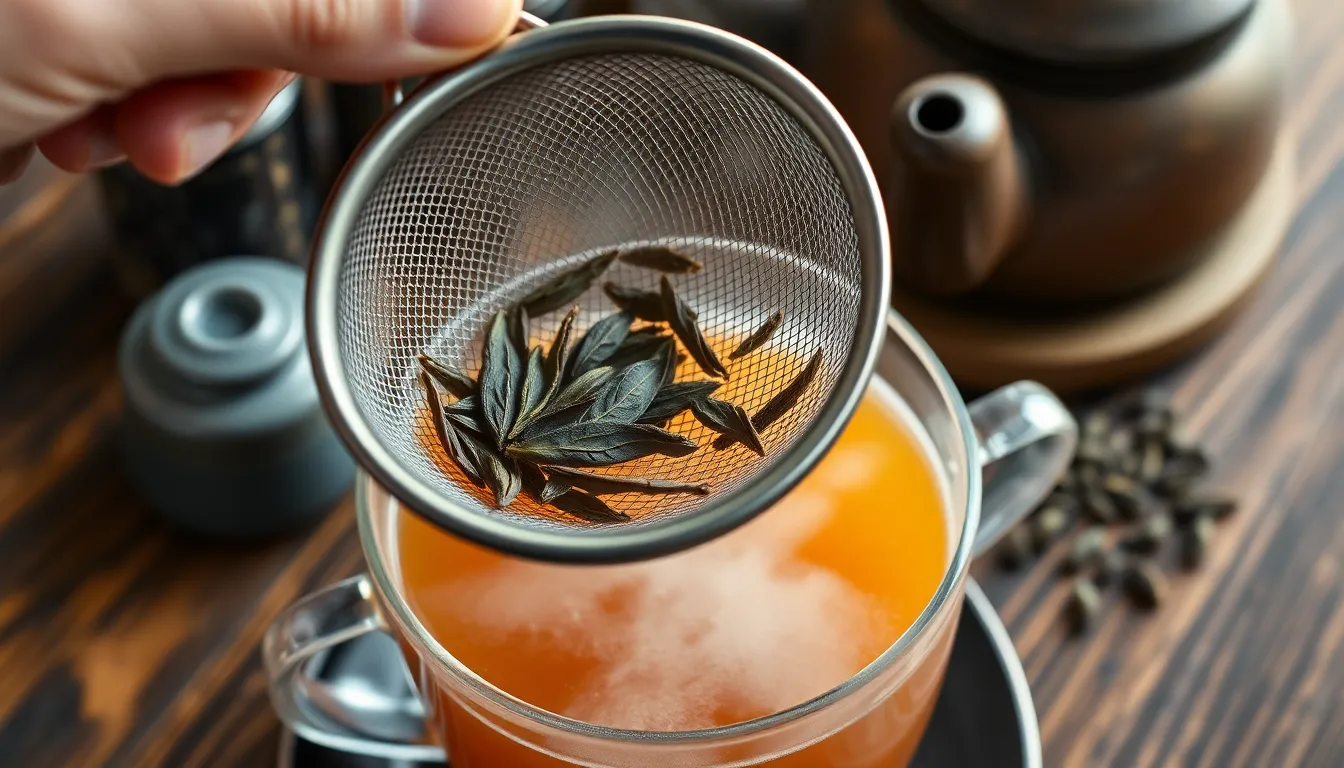
When you need to brew loose leaf tea but lack an infuser, a fine mesh sieve becomes your reliable brewing companion. This versatile approach allows you to steep tea leaves freely while ensuring a smooth, particle-free cup.
Prep
We start by selecting our preferred loose leaf tea, measuring approximately 2-3 teaspoons for every 8-10 ounces of water. Heat filtered water to the appropriate temperature based on your tea type – delicate white and green teas require cooler water around 160-180°F, while black teas need fully boiling water at 200-212°F. Gather a clean fine mesh sieve and ensure you have both a brewing vessel and a serving cup ready for the straining process.
Brew
Place the loose leaf tea directly into a teapot, large mug, or any heat-resistant container that allows the leaves room to expand. Pour the heated water over the tea leaves, covering them completely to ensure even extraction. Allow the tea to steep for the recommended time – typically 3-5 minutes for black teas, 2-3 minutes for green teas, and 1-2 minutes for delicate white teas. During steeping, the leaves will unfurl and release their flavors into the water, creating a rich, aromatic brew.
Strain
Position the fine mesh sieve directly over your serving cup, ensuring it sits securely to catch all tea particles. Pour the brewed tea slowly and steadily through the sieve, allowing the liquid to pass through while capturing the spent leaves. For smaller sieves, we can place them directly over the mug during steeping, then lift and transfer the liquid to a clean cup for serving. Dispose of the caught tea leaves in compost or trash, and rinse the sieve immediately to prevent staining and maintain its effectiveness for future brewing sessions.
Method 5: The Gravity Method
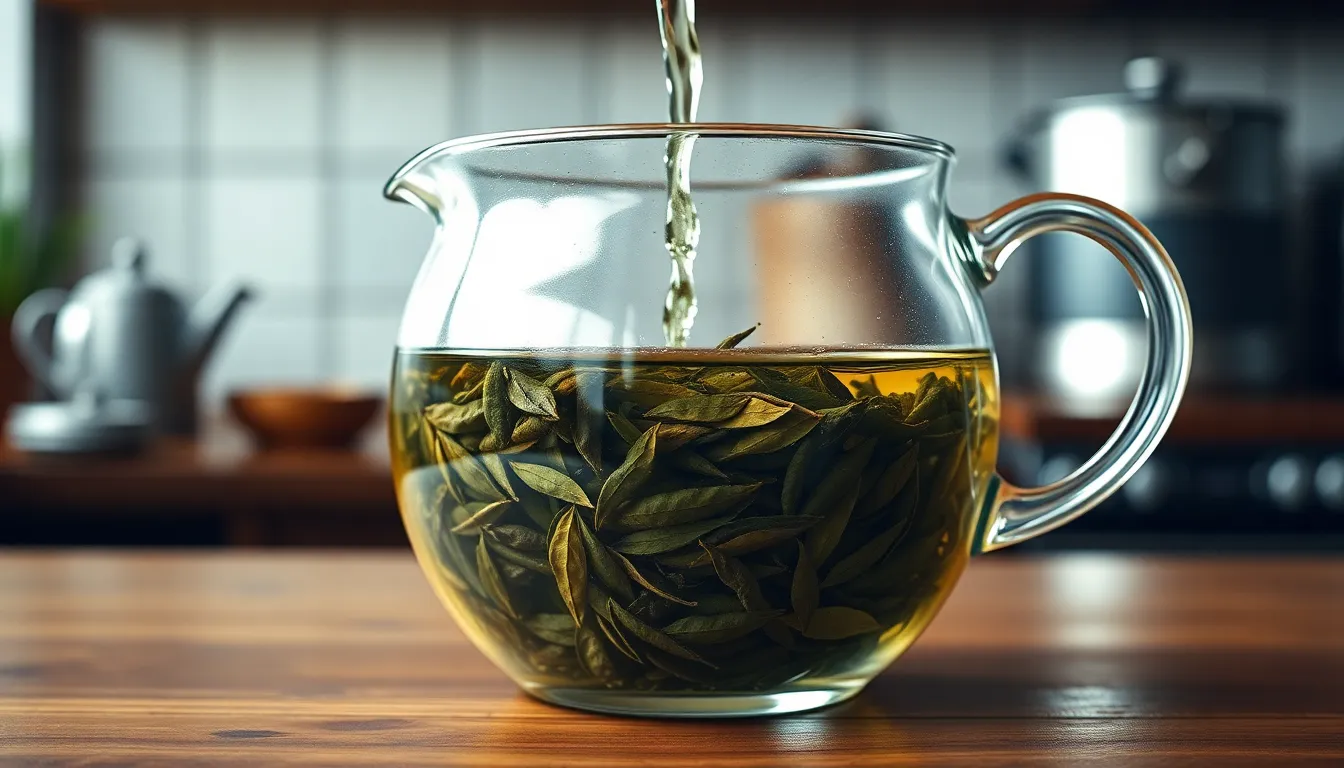
The gravity method harnesses natural physics to separate tea leaves from your brew without any special equipment. We rely on the simple principle that tea leaves will naturally settle to the bottom of your vessel after steeping.
Prep
We begin by selecting our loose leaf tea and measuring the desired amount based on our taste preferences. Our brewing vessel should be a glass or cup wide enough to allow the tea leaves room to expand fully during steeping. Fresh filtered water becomes our foundation for optimal flavor extraction. We heat the water to the appropriate temperature for our exact tea type.
| Tea Type | Water Temperature |
|---|---|
| Black Tea | Near boiling (200-212°F) |
| Green Tea | Lower temperature (160-180°F) |
| White Tea | Moderate heat (175-185°F) |
| Oolong Tea | Hot water (185-205°F) |
Brew
We place the loose tea leaves directly into our chosen cup or vessel without any barriers. Our hot water pours gently over the leaves while we aim toward the back of the vessel. This pouring technique creates a natural vortex or spiral effect that promotes turbulence. The movement helps tea leaves open fully and steep evenly throughout the brewing process.
We allow our tea to steep for the recommended time based on the variety we’ve chosen. During this steeping period the leaves expand and release essential flavor compounds including polyphenols, amino acids, and natural sugars into the water.
| Tea Type | Steeping Time |
|---|---|
| Black Tea | 3-5 minutes |
| Green Tea | 2-3 minutes |
| White Tea | 4-6 minutes |
| Oolong Tea | 3-5 minutes |
Settle and Pour
After our steeping time completes we pause and allow the tea leaves to settle naturally at the bottom of our cup. Gravity works as our simple filter by causing the expanded leaves to sink without any external force. We wait patiently as this natural settling process eliminates the need for physical straining tools.
Our final step involves slowly pouring the brewed tea into a clean cup while leaving the settled leaves behind in the original vessel. This careful pouring technique prevents leaf sediment from transferring to our drinking cup. The natural separation process reduces debris in our final brew while maximizing flavor extraction that occurs when leaves have ample space to expand during steeping.
Instructions for Perfect Results
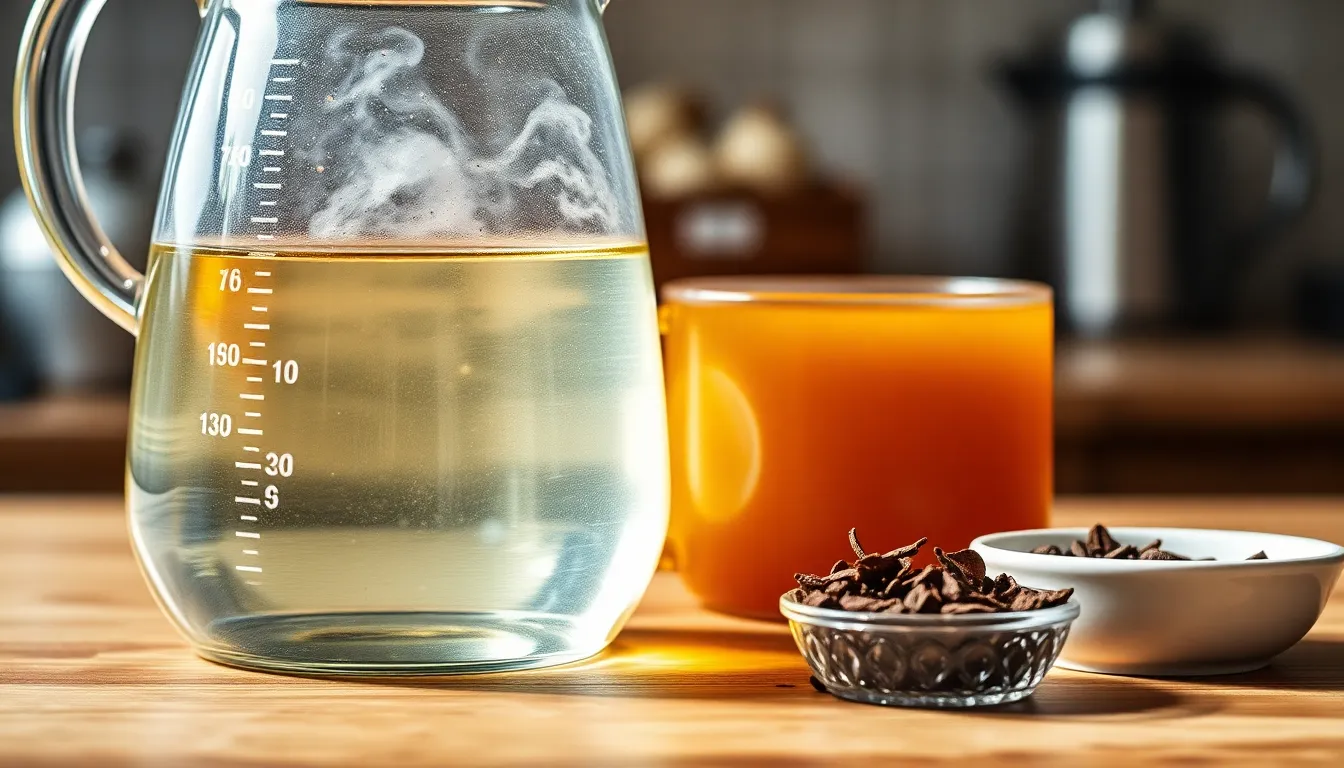
We achieve the best flavor extraction when we follow exact brewing parameters for loose leaf tea. These guidelines ensure consistent and delicious results regardless of which method we choose.
Water Temperature Guidelines
Different tea varieties require exact water temperatures to unlock their optimal flavor profiles. Black tea performs best with boiling water at 212°F since its robust leaves can handle the intense heat. Green tea needs gentler treatment with water heated to 170°F to 180°F to preserve its delicate compounds and prevent bitterness. White tea demands the most careful approach with water temperatures between 150°F to 160°F to maintain its subtle flavors.
We recommend using a thermometer for precision or letting boiling water cool for exact intervals. After boiling, water reaches green tea temperature after cooling for 3 to 4 minutes. White tea temperature requires 5 to 6 minutes of cooling time from the boiling point.
Steeping Time Recommendations
Proper timing prevents over-extraction and ensures balanced flavor development in our tea. Black tea achieves its full-bodied character with steeping times of 3 to 5 minutes. Green tea reaches peak flavor between 2 to 3 minutes of steeping time. White tea delivers its gentle essence within 2 to 3 minutes of contact with hot water.
| Tea Type | Steeping Time | Temperature |
|---|---|---|
| Black Tea | 3-5 minutes | 212°F |
| Green Tea | 2-3 minutes | 170°F-180°F |
| White Tea | 2-3 minutes | 150°F-160°F |
We suggest starting with shorter steeping times and adjusting based on personal taste preferences. Longer steeping times increase strength but may introduce unwanted bitterness.
Tea-to-Water Ratios
The foundation of excellent tea lies in using the correct proportions of leaves to water. We use one teaspoon of loose leaf tea per 8 ounces of water as our standard measurement for black tea. Green and white teas often require slight adjustments based on leaf size and desired strength.
Dense tea leaves like rolled oolongs need less volume per cup compared to fluffy white tea leaves. We measure by weight when possible, using approximately 2 to 3 grams of tea per 8 ounces of water for consistent results. Personal preference plays a important role in determining the ideal ratio, so we encourage experimentation within these guidelines.
Tips for Success
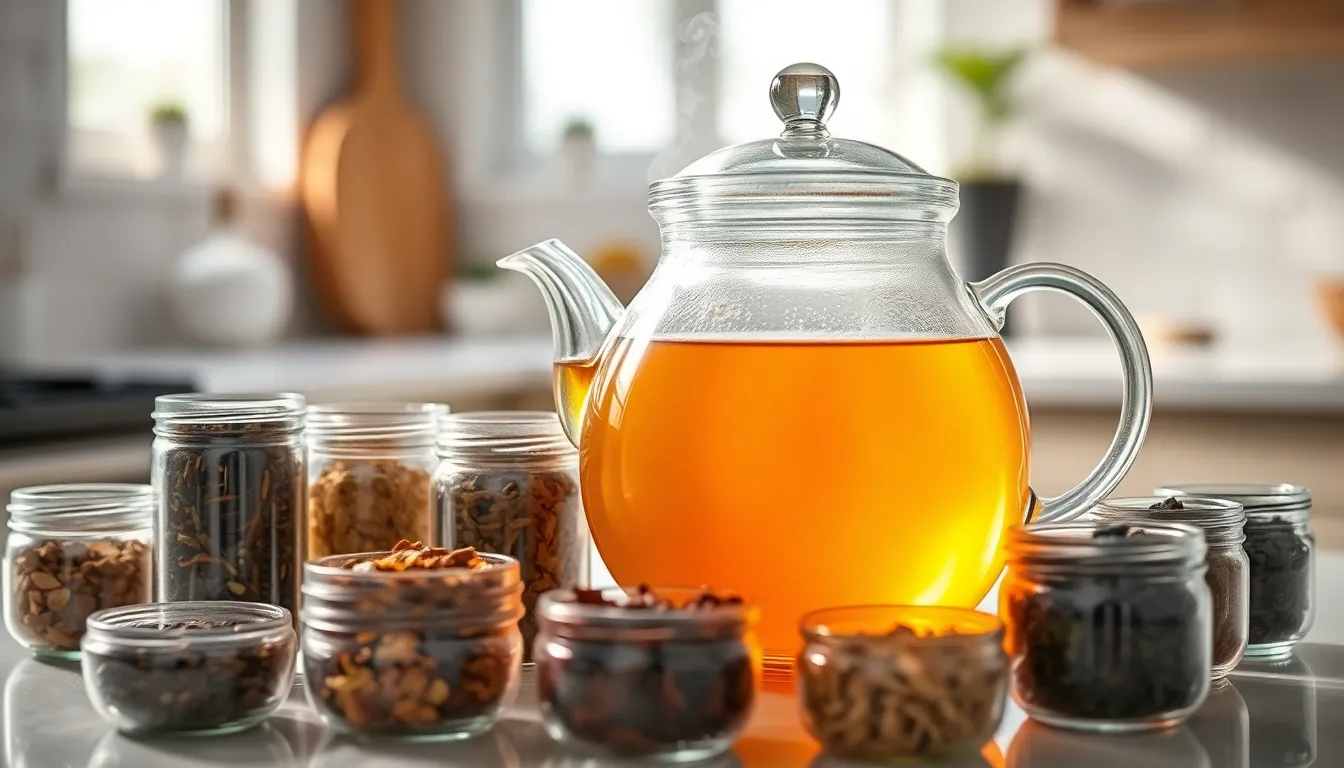
Success in brewing loose leaf tea without an infuser depends on selecting appropriate tea varieties and maintaining proper storage practices. We’ve found that these essential considerations significantly impact the quality of your final cup.
Choosing the Right Tea
We recommend starting with robust tea varieties that can withstand direct brewing methods. Herbal teas like Sobacha or Kuromamecha work exceptionally well for techniques where leaves remain in contact with water longer. Black teas perform beautifully with the gravity method since their sturdy leaves settle effectively at the bottom of your vessel.
Green and white teas require more careful handling due to their delicate nature. We suggest using the fine mesh sieve method for these varieties to prevent oversteeping and bitter flavors. Oolong teas adapt well to most brewing methods but show their best characteristics when brewed using the French press technique.
Consider the leaf size when selecting your tea. Larger leaf teas like white tea pearls or rolled oolongs work perfectly with gravity settling methods. Smaller leaf teas and broken grades perform better with strainer techniques or coffee filter methods where particles need containment.
Storage and Cleanup
We store our loose leaf teas in airtight containers placed in cool dry locations away from direct sunlight. Metal tins or glass jars with tight sealing lids preserve freshness best and prevent moisture absorption that can compromise flavor quality.
Proper equipment maintenance ensures consistent brewing results. We clean all brewing vessels with hot soapy water immediately after use to prevent residual tea oils from affecting future brews. Rinse thoroughly and dry completely before storing to avoid any lingering soap flavors.
Fine mesh sieves require special attention during cleaning. We use a soft brush to remove any trapped tea particles from the mesh openings. Coffee filters should be discarded after single use while reusable cloth filters need thorough washing and complete drying between brewing sessions.
Store your brewing equipment in designated areas where they won’t absorb kitchen odors. We keep our tea brewing tools separate from heavily scented items like coffee or spices to maintain pure tea flavors in every cup.
Troubleshooting Common Issues
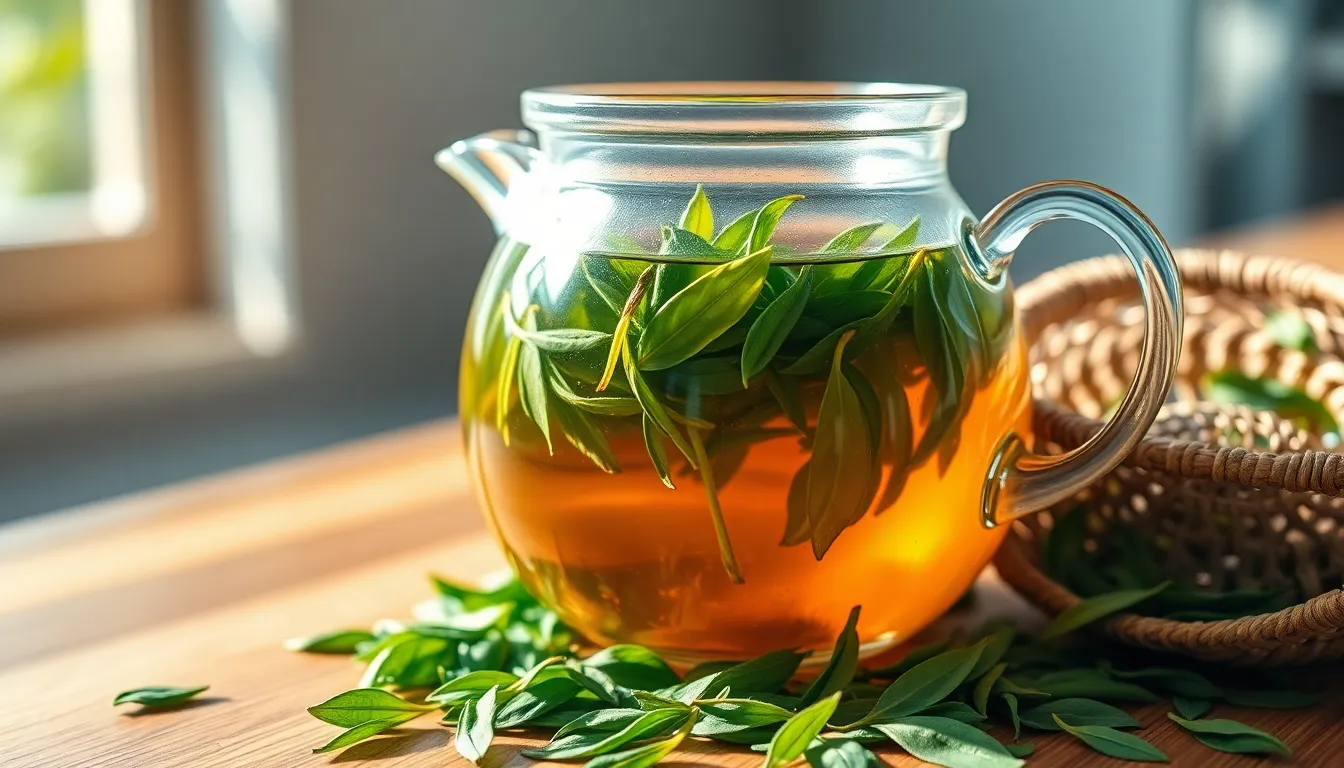
Tea particles floating in our cup represent the most frequent challenge when brewing loose leaf tea without an infuser. We encounter this problem primarily when the tea leaves are too finely broken or powdery to be effectively caught by our makeshift straining methods. Double straining through both a coarse and fine mesh sieve eliminates stubborn particles that slip through single-layer filtration systems.
Water temperature mistakes create another common brewing obstacle that affects our final cup quality. Black teas require water heated to 200-212°F while green teas need gentler temperatures between 160-180°F to prevent bitter compounds from overwhelming the delicate flavors. White teas demand the most careful attention with water temperatures staying below 175°F for optimal extraction.
Over-steeping leads to bitter and astringent tea that masks the intended flavor profile we’re seeking. We monitor steeping times closely with black teas requiring 3-5 minutes and green teas needing only 2-3 minutes for proper extraction. Herbal teas prove more forgiving and can steep longer without developing harsh flavors.
| Tea Type | Water Temperature | Steeping Time | Common Issues |
|---|---|---|---|
| Black Tea | 200-212°F | 3-5 minutes | Over-extraction, bitterness |
| Green Tea | 160-180°F | 2-3 minutes | Burnt taste from hot water |
| White Tea | 160-175°F | 4-6 minutes | Weak flavor from cool water |
| Herbal Tea | 200-212°F | 5-7 minutes | Under-extraction |
Weak tea results from insufficient leaf quantity or inadequate steeping time during our brewing process. We increase the tea amount to 1.5 teaspoons per 8 ounces of water when using the grandpa style method since direct contact allows for stronger extraction. Adding more leaves proves more effective than extending steeping time beyond recommended ranges.
Clogged strainers become problematic when fine tea particles accumulate during repeated use without proper cleaning. We rinse our fine mesh sieves immediately after each brewing session and use a soft brush to remove stubborn residue that affects water flow. Coffee filters require replacement after 2-3 uses to maintain optimal filtration performance.
Equipment compatibility issues arise when our chosen brewing vessel doesn’t accommodate the straining method effectively. Mason jars work best with the gravity method while wide-mouth containers support the strainer technique more efficiently. We select brewing vessels that complement our chosen separation method for smoother tea preparation.
Conclusion
We’ve shown you that brewing exceptional loose leaf tea doesn’t require expensive infusers or specialized equipment. With simple kitchen tools like fine-mesh sieves coffee filters and even gravity itself you can create the perfect cup every time.
These methods aren’t just backup answers – they’re legitimate brewing techniques that many tea enthusiasts prefer for their flexibility and enhanced flavor extraction. Whether you’re using the French press method or letting leaves settle naturally each approach offers its own unique advantages.
The beauty of these techniques lies in their accessibility and simplicity. You likely already have everything you need in your kitchen right now. Start experimenting with these methods and discover which one works best for your favorite teas and personal preferences.
Frequently Asked Questions
Can I brew loose leaf tea without a tea infuser or strainer?
Yes, you can brew loose leaf tea without specialized equipment using everyday kitchen items. Methods include the grandpa style (letting leaves settle naturally), coffee filters as makeshift tea bags, fine-mesh sieves for straining, French press brewing, and the gravity method where leaves settle at the bottom of your cup.
What basic equipment do I need to brew loose leaf tea at home?
You need quality loose leaf tea, filtered water, and a brewing vessel like a teapot or large mug. A fine-mesh kitchen strainer works well for separating leaves. Optional items include coffee filters, cheesecloth, a timer, and a small bowl for certain brewing methods.
How much loose leaf tea should I use per cup?
Use 2-3 teaspoons of loose leaf tea for 8-10 ounces of water as a general guideline. Start with one teaspoon per 8 ounces and adjust based on your taste preferences. Stronger teas may require less, while lighter teas might need more.
What water temperature should I use for different types of tea?
Use boiling water (212°F) for black teas and herbal teas. Green teas require cooler water around 175-185°F to prevent bitterness. White teas need the gentlest treatment at 160-175°F. Proper temperature ensures optimal flavor extraction without over-brewing.
How long should I steep loose leaf tea?
Steeping times vary by tea type: black tea 3-5 minutes, green tea 2-3 minutes, white tea 2-4 minutes, and herbal teas 5-7 minutes. Over-steeping can cause bitterness, while under-steeping results in weak flavor. Use a timer for consistency.
What’s the grandpa style method of brewing tea?
The grandpa style involves adding loose tea leaves directly to your cup or mug, pouring hot water over them, and letting the leaves settle naturally at the bottom. You drink from the top, allowing the leaves to remain at the bottom throughout multiple infusions.
Can I use a French press to brew loose leaf tea?
Yes, a French press works excellently for brewing loose leaf tea. Add tea leaves to the press, pour hot water over them, let steep for the appropriate time, then slowly press the plunger down to separate the leaves from the brewed tea.
How do I clean my tea brewing equipment properly?
Rinse all equipment with hot water immediately after use. For fine mesh sieves, use a soft brush to remove stuck particles. Clean coffee filters thoroughly if reusing. Avoid soap on porous materials like unglazed clay, as it can absorb flavors and affect future brews.
Why does my tea taste bitter or weak?
Bitter tea usually results from water that’s too hot or over-steeping. Weak tea comes from insufficient tea quantity, water that’s too cool, or under-steeping. Adjust water temperature, steeping time, and tea quantity to achieve your preferred strength and flavor balance.
What should I do if tea particles float in my brewed tea?
Tea particles typically result from finely broken leaves or inadequate straining. Try double-straining through a finer mesh, use coffee filters for additional filtering, or switch to larger leaf teas that settle more easily. The gravity method also helps particles settle naturally.

